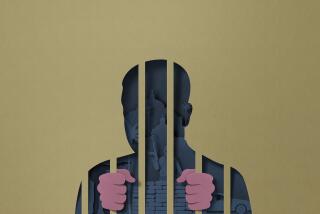After 3 Years in Jail, Ramirez Will Go on Trial Today in 13 Night Stalker Murders
The object of a massive police manhunt at age 25, Richard Ramirez has marked three birthdays in a tiny, pale-blue cell in the Los Angeles County Jail, reading, exercising and, occasionally, boasting about the Night Stalker killings with which he is charged.
This morning, a month shy of his 29th birthday, the drifter from El Paso, Tex., goes on trial for his life. But if Ramirez harbors any trepidations about the possibility of going to the gas chamber, he does not show it.
In court, he became a studious participant in the preparation of his defense, taking notes and consulting animatedly with members of his legal team as they went about selecting a jury.
His only distractions seem to come when a woman enters the courtroom, prompting him to turn his head for a close once-over.
Low-Keyed Demeanor
Ramirez’s low-keyed courtroom demeanor during the last six months of jury selection is in marked contrast to an earlier court appearance in which he flashed a pentagram drawn on his palm and yelled, “Hail Satan!” after pleading not guilty.
Such bizarre behavior probably had to do with his being upset at his previous attorneys, according to Daniel Hernandez, who was hired by Ramirez after the defendant had a falling out with two court-appointed public defenders and another lawyer, all shortly after his arrest.
Ramirez is charged with 13 murders in a terrifying spree of nighttime residential attacks in Los Angeles County that also left many others injured. He faces 30 other felony counts, including attempted murder, rape and forced oral copulation. The defendant is also charged with a 14th murder in San Francisco and an attempted murder and sexual assault in Orange County.
At the jail downtown, Ramirez remains isolated in a windowless, 10-by-12-foot cell, devouring newspapers, magazines and books, including a recent biography of the late actor David Niven, according to Richard Salinas, a paralegal who is assisting Hernandez.
Aside from his frequent evening consultations with Hernandez, the defendant is allowed one visit a day--from “friends and family,” according to Hernandez, who declined to elaborate.
In jail, Ramirez’s ankles are not shackled, as they are in court. But whenever he is moved from his cell, to make a telephone call, for instance, a sergeant must be present, along with the customary deputies.
Also as an added precaution, Ramirez is usually transported from the jail to the Criminal Courts Building alone. Occasionally, he rides in a bus with other inmates, but even then he is segregated from the others.
At the jail, there is a “special Ramirez watch,” which means that a sheriff’s deputy is posted just outside Cell No. 7021 and looks in on Ramirez every 15 minutes through a rectangular, plate-glass window in the steel door.
Chilling Monologue
Sheriff’s Deputy Jim Ellis was on such a watch on Oct. 10, 1985, when Ramirez launched into a chilling monologue, according to court documents.
“I killed 20 people in California. I was a super-criminal,” Ramirez told Ellis. “No one could catch me. Then I (expletive) up and left one goddamn fingerprint and they caught me.”
Recounting a murder in San Francisco for which he has been charged separately, Ramirez said: “I walked up the stairs real slow and got into the house, and then I went into the bedroom and saw these two people sleeping there and then, boom, boom. I did them in.”
He went on: “I love to kill people. I love watching people die. I would shoot them in the head, and they would wiggle and squirm all over the place and then just stop. Or cut them with a knife and watch the face turn real white. I love all that blood. One time I told this lady to give me all her money. She said no. So I cut her and pulled her eyes out,” he said, referring to one of his alleged victims.
While making these comments, Ramirez occasionally paused to “laugh a little bit,” Ellis reported.
Co-prosecutor Phil Halpin said he will seek to introduce these statements as evidence in the trial.
Moments earlier, Ramirez had expressed a suspicion that his food and drink were being drugged, and flushed a portion of the meal down the toilet.
Four months later, Deputy Robert Anderson was on watch when Ramirez slipped a postcard under the door, asking Anderson to mail it.
“Read the back of it,” Ramirez urged. “It rhymes like a poem.” The jingle contained a threat against a former acquaintance.
Ramirez’s message was that “he was going to get anybody who is directly involved with turning him in to the police,” according to Anderson’s account of the incident.
It was also from jail that Ramirez allegedly said last August that someone would slip him a gun so he could “get the D.A.” and then turn it on others in the courtroom.
According to County Deputy Public Defender Hank Hall, who initially represented Ramirez, a court-appointed psychologist in 1985 had found him to be “borderline competent” after a 10- to 15-minute discussion that was abruptly terminated by Ramirez.
That session had to be delayed a day because, Hall told Los Angeles Municipal Judge Elva R. Soper, Ramirez was “acting up in the lockup.”
During that same 1985 court proceeding, Soper observed: “Up to this point, the questions I have asked Mr. Ramirez, he has answered in a logical, intelligent fashion.”
Ramirez replied: “I am sane.”
He added that he has had 11 years of education, plus one year of studies in the electrical trade. Then he volunteered: “I have a psychologist in Los Angeles who has qualified me sane. . . . I don’t want to go to no hospital, ma’am.” He did not elaborate.
The tall, lanky Ramirez usually appears in court wearing a dark suit, and often with sunglasses. When he speaks, which is rare, it is in a husky voice.
In mid-January, when Los Angeles Superior Court Judge Michael A. Tynan asked Ramirez if he joined in a defense motion for a mistrial, he replied with aplomb: “I think you should rule on it. If the law is that I have to answer, then I’d like to talk to him (Hernandez) first.”
After conferring with Hernandez, Ramirez told the judge: “Yes, I concur.”
Tynan has estimated that the trial may take as long as two years.
More to Read
Sign up for Essential California
The most important California stories and recommendations in your inbox every morning.
You may occasionally receive promotional content from the Los Angeles Times.










